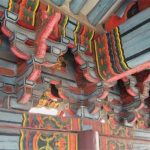The Pothong Gate in Pothongmun-dong, Central District, Pyongyang, is preserved as a historical relic showing the fine architectural skills of Korean ancestors.
It was erected when the Walled City of Pyongyang, the capital of Koguryo, was built around the mid-6th century. The present gate was rebuilt in 1473.
As a gateway to northwest Walled City of Pyongyang, it was considered a vantage point in the light of national defence and transportation in the periods of Koguryo, Koryo and the feudal Joson dynasty.
The grandiose yet well-balanced gate consists of the embankment piled with trimmed pieces of granite and the two-storeyed gatehouse built on it.
The high embankment and the archway 4.4 m in width and 4.55 m in height show the Korean ancestors’ high skill of piling stones.
The gatehouse with gabled eaves is 14. 8 metres long (3 bays) and 9.15 metres wide (3 bays). Bulged pillars support the head space.
The Pothong Gate is a priceless national cultural heritage handed down from Koguryo, Koryo and the feudal Joson dynasty up to the present, together with the time-honoured Pyongyang and places an important position in the research of the Walled City of Pyongyang.






